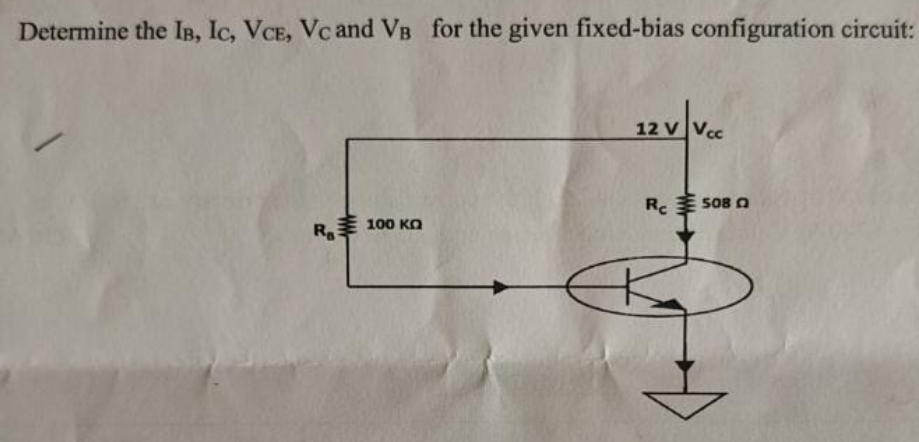Determine the IB, IC, VCE, VC and VB for the given fixed-bias configuration circuit.

Understand the Problem
The question is asking for calculations related to a fixed-bias transistor circuit. This involves finding the values of base current (IB), collector current (IC), collector-emitter voltage (VCE), collector voltage (VC), and base voltage (VB) based on the given circuit configuration and resistor values.
Answer
$I_B \approx 113 \, \mu A$, $I_C \approx 11.3 \, mA$, $V_{CE} \approx 6.26 \, V$, $V_C \approx 6.26 \, V$, $V_B = 12 \, V$
Answer for screen readers
- $I_B \approx 113 , \mu A$
- $I_C \approx 11.3 , mA$
- $V_{CE} \approx 6.26 , V$
- $V_C \approx 6.26 , V$
- $V_B = 12 , V$
Steps to Solve
- Find the Base Voltage (VB)
The base voltage ($V_B$) can be calculated using the voltage divider formula. The voltage from the supply ($V_{CC}$) is divided among the resistors $R_B$ and the base-emitter junction of the transistor.
$$ V_B = V_{CC} \cdot \frac{R_B}{R_B + R_E} $$
Where $R_E$ is typically the resistance between the emitter and ground. In this scenario, we will assume it is equal to $0 , \Omega$ for simplicity.
$$ V_B = 12V \cdot \frac{100kΩ}{100kΩ + 0Ω} = 12V $$
- Calculate Base Current (IB)
Using the base-emitter voltage drop ($V_{BE}$), typically around $0.7V$ for silicon transistors, we can find the base current ($I_B$) with Ohm’s Law:
$$ I_B = \frac{V_B - V_{BE}}{R_B} $$
$$ I_B = \frac{12V - 0.7V}{100kΩ} = \frac{11.3V}{100kΩ} = 0.000113 A = 113 \mu A $$
- Find Collector Current (IC)
The collector current ($I_C$) can be approximated using the transistor's current gain ($\beta$). Assuming a $\beta$ value of around 100:
$$ I_C \approx \beta \cdot I_B $$
$$ I_C \approx 100 \cdot 113 \mu A = 11.3 mA $$
- Find Collector-Emitter Voltage (VCE)
Next, we find the collector-emitter voltage ($V_{CE}$) using Kirchhoff’s Voltage Law in the output loop:
$$ V_{CE} = V_{CC} - I_C \cdot R_C $$
Calculating $V_{CE}$:
$$ V_{CE} = 12V - (11.3 mA \cdot 508Ω) $$
Converting the collector current into Amperes:
$$ I_C = 11.3 mA = 0.0113 A $$
Thus,
$$ V_{CE} = 12V - (0.0113 A \cdot 508Ω) = 12V - 5.7404 V \approx 6.2596 V $$
- Calculate Collector Voltage (VC)
The collector voltage ($V_C$) can then be calculated by:
$$ V_C = V_{CC} - I_C \cdot R_C $$
Using the previous values:
$$ V_C = 12V - 5.7404 V \approx 6.2596 V $$
- Summary:
To summarize, we have calculated:
- $I_B \approx 113 \mu A$
- $I_C \approx 11.3 mA$
- $V_{CE} \approx 6.2596V$
- $V_C \approx 6.2596V$
- $V_B = 12V$
- $I_B \approx 113 , \mu A$
- $I_C \approx 11.3 , mA$
- $V_{CE} \approx 6.26 , V$
- $V_C \approx 6.26 , V$
- $V_B = 12 , V$
More Information
The calculations above illustrate the basic functioning of a fixed-bias configuration transistor circuit. The transistor amplifies the input current into a larger output current while maintaining a specified relationship between voltage and current.
Tips
- Forgetting to account for the base-emitter voltage drop ($V_{BE}$) can lead to an incorrect base current calculation.
- Assuming a $\beta$ value without knowing the specific transistor's datasheet may lead to inaccuracies.
- Not recognizing that the values can slightly vary in practical circuits due to temperature changes or component tolerances.
AI-generated content may contain errors. Please verify critical information